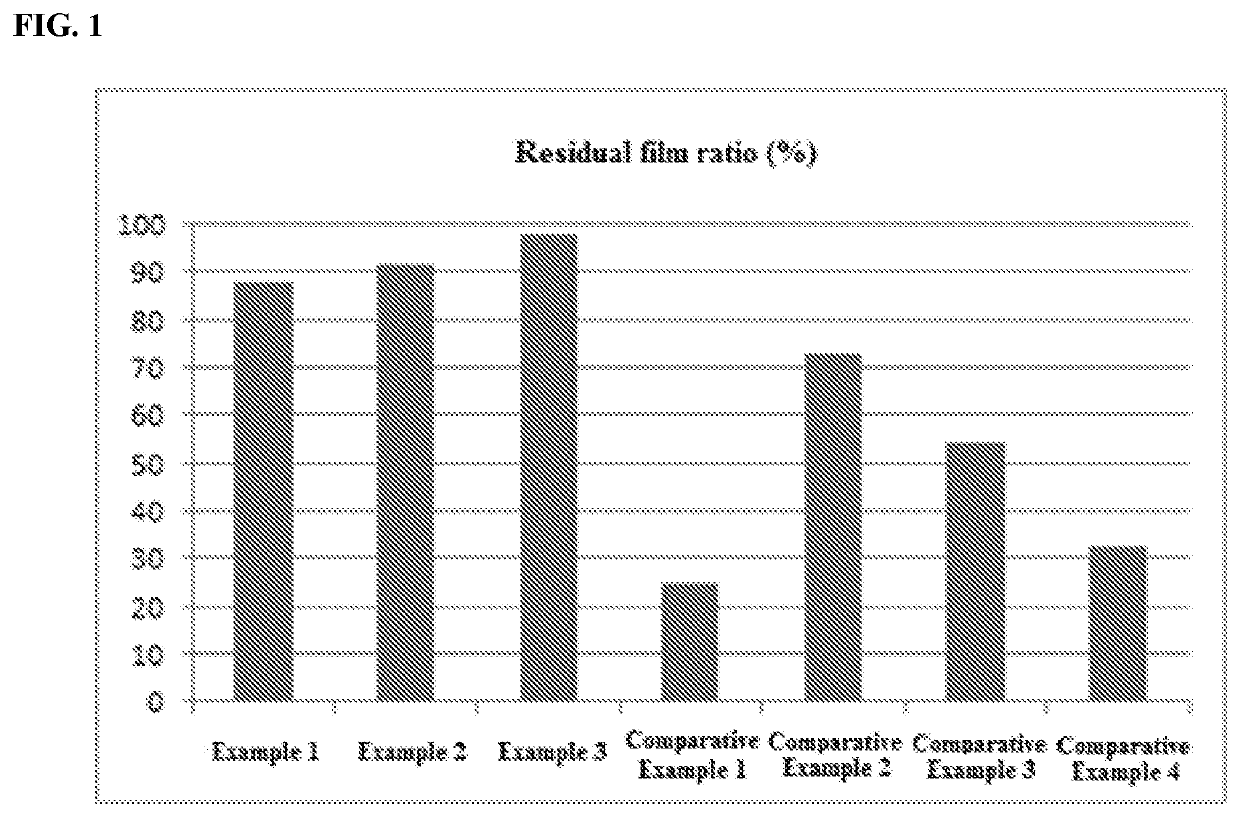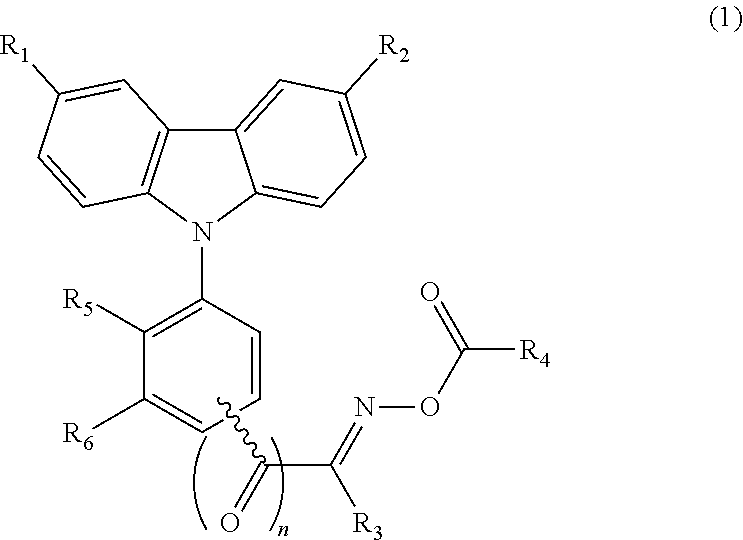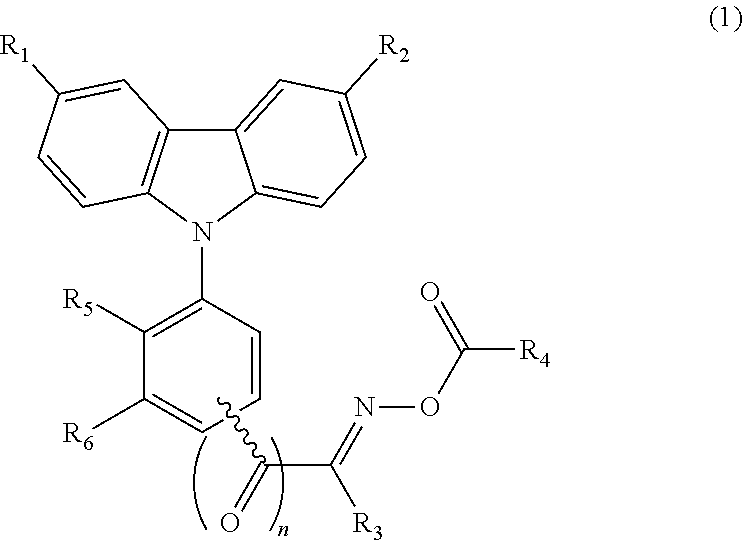Highly sensitive oxime ester photopolymerization initiator and photopolymerizable composition including the same
a photopolymerization initiator and high-sensitivity technology, applied in the field of high-sensitivity oxime ester photopolymerization initiator and photopolymerizable composition including the same, can solve the problems of deteriorating the adhesiveness of photosensitive compositions and low yield, and achieve the effects of reducing the phase separation between the binder and the photoinitiator, reducing the yield and reducing the yield
- Summary
- Abstract
- Description
- Claims
- Application Information
AI Technical Summary
Benefits of technology
Problems solved by technology
Method used
Image
Examples
examples 1-9
Example 1
[0068]
Step 1: Synthesis of 1-(4-(9H-carbazol-9-yl)phenyl)ethanone
[0069]A mixture of 9H-carbazole (16.7 g, 100 mmol), 4-bromoacetophenone (25 g, 125 mmol), CuI (2.0 g, 10 mmol), and 18-crown-6 (1.3 g, 5 mmol) was dissolved in dimethylformamide (DMF, 100 mL). The resulting solution was refluxed under a nitrogen atmosphere for 24 h. After completion of the reaction, the reaction mixture was allowed to cool to room temperature. The reaction mixture was poured into 300 mL of water and 200 mL of dimethylene chloride (DMC) was then added thereto. The mixture was stirred vigorously and filtered. The organic layer was separated, dried over Na2SO4, evaporated to obtain a brown solid, added with a small amount (50 mL) of acetone, stirred, and filtered to obtain a light brown solid. The solid was dissolved in ethyl acetate (EA) and purified by recrystallization to yield the title compound as a light brown microcrystal. The filtrate was concentrated and left standing at room temperature...
examples 2-9
[0077]The compounds shown in Table 1 were synthesized in the same manner as in Example 1, except that the corresponding reactants were used.
TABLE 1ExampleFormulaNo.No.R1R2R3R4R5R61H-NMR (δ, ppm)21-2—NO2—H—C3H7—CH3—H—H9.05 (d, 1H), 8.32 (dd, 1H), 8.23(d, 1H), 8.03 (d, 2H), 7.62 (d, 2H),7.53 (t, 1H), 7.44-7.40 (m, 3H),2.94 (t, 2H), 2.31 (s, 3H), 1.70-1.47(m, 2H), 0.94 (t, 3H)31-3—NO2—H—C5H11—CH3—H—H9.06 (d, 1H), 8.34 (dd, 1H), 8.21(d, 1H), 8.01 (d, 2H), 7.62 (d, 2H),7.53 (t, 1H), 7.44-7.40 (m, 3H),2.94 (t, 2H), 2.31 (s, 3H), 1.69-1.46(m, 2H), 1.44-1.38 (m, 4H), 0.94 (t,3H)41-4—NO2—H—C7H15—CH3—H—H9.06 (d, 1H), 8.34 (dd, 1H), 8.21(d, 1H), 8.01 (d, 2H), 7.62 (d, 2H),7.53 (t, 1H), 7.44-7.40 (m, 3H),2.94 (t, 2H), 2.31 (s, 3H), 1.69-1.46(m, 2H), 1.46-1.36 (m, 8H), 0.94 (t,3H)51-5—NO2—H—CH3—H—H9.08 (d, 1H), 8.32 (dd, 1H), 8.22 (d, 1H), 8.00 (d, 2H), 7.61 (d, 2H), 7.53 (t, 1H), 7.48-7.46 (m, 5H), 7.44-7.40 (m, 3H), 2.31 (s, 3H)61-6—NO2—H—CH3—H—H9.08 (d, 1H), 8.34 (dd, 1H), 8.21 (d, 1H), 8.01 ...
examples 10-18
Example 10
[0081]
Step 1: Synthesis of 1-(4-(9H-carbazol-9-yl)-2-methylphenyl)ethanone
[0082]A mixture of 9H-carbazole (16.7 g, 100 mmol), 1-(4-bromo-2-methylphenyl)ethanone (26.6 g, 125 mmol), CuI (2.0 g, 10 mmol), and 18-crown-6 (1.3 g, 5 mmol) was dissolved in dimethylformamide (DMF, 100 mL). The resulting solution was refluxed under a nitrogen atmosphere for 24 h. After completion of the reaction, the reaction mixture was allowed to cool to room temperature. The reaction mixture was poured into 300 mL of water and 200 mL of methylene chloride (MC) was then added thereto. The mixture was stirred vigorously and filtered. The organic layer was separated, dried over Na2SO4, evaporated to obtain a brown solid, added with a small amount (50 mL) of acetone, stirred, and filtered to obtain a light brown solid. The solid was purified by silica gel column chromatography to isolate the title compound from its other isomers (overall yield: 15.7 g, 52%).
[0083]1H-NMR (δ, ppm), CDCl3: 8.20 (d, 2H...
PUM
| Property | Measurement | Unit |
|---|---|---|
| decomposition temperatures | aaaaa | aaaaa |
| dispersity | aaaaa | aaaaa |
| temperature | aaaaa | aaaaa |
Abstract
Description
Claims
Application Information
 Login to View More
Login to View More - R&D
- Intellectual Property
- Life Sciences
- Materials
- Tech Scout
- Unparalleled Data Quality
- Higher Quality Content
- 60% Fewer Hallucinations
Browse by: Latest US Patents, China's latest patents, Technical Efficacy Thesaurus, Application Domain, Technology Topic, Popular Technical Reports.
© 2025 PatSnap. All rights reserved.Legal|Privacy policy|Modern Slavery Act Transparency Statement|Sitemap|About US| Contact US: help@patsnap.com



